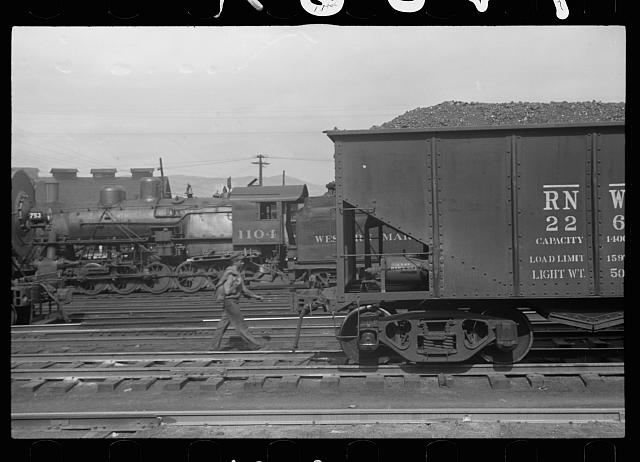Elkins
Elkins lies in a shallow, bowl-shaped valley at a five-mile bend in the Tygarts Valley River. The main part of the town extends from the north bank of the river up the gentle slopes of Cheat Mountain. The business district extends northward from the river and is flanked on the south by the West Maryland Railway tracks, shops, and yards…
-From the Federal Writers’ Project West Virginia: A Guide to the Mountain State

Elkins illustrated map, 1897. Click to enlarge. Note the train depot center right, Halliehurst and Graceland mansions on far right on hills above town, and no court house yet.

Stephen B. Elkins and Henry G. Davis, politicians and industrialists who founded the town of Elkins. Photos from the Library of Congress.
The history of Elkins is intertwined with two men and their railway, the West Virginia Central & Pittsburgh railroad. In 1880, U.S. Senator Henry G. Davis and (future U.S. Senator) Stephen B. Elkins began laying tracks for a railroad from Cumberland, Maryland down the Potomac region into the Allegheny mountains in Randolph County, West Virginia, where timber and coal were abundant. By 1889, the railway was complete to its new terminus, near the town of Leadsville on the bank of the Tygart Valley River. That year, the railroad’s engineers finished laying out the new town and building the railroad yards for the town, and it would be incorporated as Elkins in 1890.
Elkins quickly developed into a major business and transportation center for the region. New homes were needed for the influx of railroad workers and management personnel, as well as businessmen and merchants who were attracted to the growing town. New banks, hotels, grocery stores, and an opera house were built. By 1900, Elkins had grown to a population of 3,000. Elkins and Davis built lavish homes in the new town, Halliehurst and Graceland, both of which can be found today on the campus of Davis & Elkins College.

Randolph County Courthouse, Elkins, ca. 1915. Courtesy of the West Virginia and Regional History Collection, WVU.
Randolph County Courthouse, Elkins, ca. 1915. Courtesy of West Virginia and Regional History Collection, WVU Libraries.Following the pattern of many new railroad towns in West Virginia, the town of Elkins soon petitioned the Randolph County court to become the new county seat. This sparked conflict with Beverly, which had been county seat since 1790. A ballot was held during the election of 1898, but the results were disputed. Winding its way through the court system, the issue was finally decided by the State Supreme Court in favor of Elkins, but not before citizens from each town reportedly took up arms in preparation for pitched battle. Luckily, fighting never occurred, and in 1902 construction began on an elegant courthouse, befitting of the new seat of power and the rapidly growing industrial and population center. In 1905, Henry G. Davis’ Coal & Coke Railway was completed from Elkins to Charleston, accelerating Elkins’ growth even further.

U.S. Senators Stephen B. Elkins (served 1895-1911) and Henry G. Davis (served 1871-1883) donated land and money just outside of town to establish a new Presbyterian college in 1901. It would become Davis & Elkins college, and both ex-Senators’ estates of Halliehurst and Graceland would be donated and incorporated into the college. Davis & Elkins College is the home of the Augusta Heritage Center, which hosts heritage-arts workshops throughout the year, fostering traditional music and arts in the region.

Birdseye View of Davis Ave.; Elkins, W. Va. ca. 1907. From the West Virginia and Regional History Collection, WVU.
By the 1930s, Elkins had become a passenger railway hub, receiving daily passenger trains at its depot. It also became the center of the new Monongahela National Forest, established in 1920 and today encompassing over 920,000 acres of federally owned forest. In 1937, a new Forest Service headquarters office building was dedicated near downtown Elkins and it remains the administrative center of the national forest. In addition, Elkins held its first Mountain State Forest Festival in 1930, an annual festival featuring events and competitions related to agriculture and forestry.
With the decline of rail transportation throughout the mid-twentieth century, both passenger and commercial services began to disappear by the end of 1980s. More recently, Elkins has seen growth in tourism, and trains have begun running again as tourist trains have become popular, like the Greenbrier Valley & Durbin Railway. The Cheat Mountain Salamander runs frequently from Elkins up to the old logging and ghost town of Spruce. Check out the Traveling 219 story on that trip here.

Train depot in Elkins, 2013. Photo by Dan Schultz.
Category: Elkins to Marlinton, Stories














